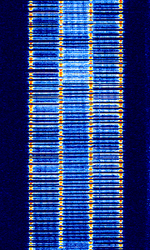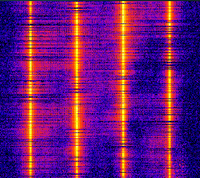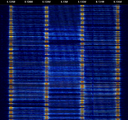CIS FTM-4
 | |
|---|---|
| Frequencies | 4 MHz,20 MHz |
| Frequency Range | 4 MHz - 20 MHz |
| Mode | USB |
| Modulation | MFSK |
| ACF | — |
| Emission Designator | — |
| Bandwidth | 13 kHz |
| Location | Russia |
| Short Description | CIS FTM-4 is the unofficial designation of a four-tone MFSK data mode which is apparently used by Russian military. |
| I/Q Raw Recording | Download file |
| Audio Sample | |
CISCommonwealth of Independent States (CIS), the former Soviet Republic FTM-4 is the unofficial designation of a 4-MFSKMultiple Frequency Shift-Keying data mode which is apparently used by Russian military. It's also known with other names such as CISCommonwealth of Independent States (CIS), the former Soviet Republic 4FSK4-Level Frequency Shift Keying 150bd but the official name and equipment used to transmit it are unknown.
Samples[edit]
Showcase sample is USBUpper Side Band Modulation (Radio, referring to reception and modulation mode)Universal Serial Bus (Computer, referring to USB Ports and cables) with about 13 kHzKiloHertz (kHz) 10^3 Hz bandwidth, tuned just below the signal to 8123.5 kHzKiloHertz (kHz) 10^3 Hz so that it covers the entire signal. The NFMNarrowband Frequency Modulation and DSBDual Side Band Modulation samples below were tuned to the center frequency of 8130 kHzKiloHertz (kHz) 10^3 Hz.NFMNarrowband Frequency Modulation sample:
Narrow USBUpper Side Band Modulation (Radio, referring to reception and modulation mode)Universal Serial Bus (Computer, referring to USB Ports and cables) sample (3 kHzKiloHertz (kHz) 10^3 Hz):
DSBDual Side Band Modulation sample
| Older sample |
|---|
Frequencies[edit]
CISCommonwealth of Independent States (CIS), the former Soviet Republic FTM-4 has been used on a wide frequency range. Frequencies from 4 to 20 MHzMegaHertz (MHz) 10^6 Hz have been reported but even lower or higher frequencies may be used.
Recently used frequencies (center) include:
7780 kHzKiloHertz (kHz) 10^3 Hz
8130 kHzKiloHertz (kHz) 10^3 Hz
9042 kHzKiloHertz (kHz) 10^3 Hz
Other known frequencies include:
4053 kHzKiloHertz (kHz) 10^3 Hz
4811 kHzKiloHertz (kHz) 10^3 Hz
8130 kHzKiloHertz (kHz) 10^3 Hz
16222 kHzKiloHertz (kHz) 10^3 Hz
16343 kHzKiloHertz (kHz) 10^3 Hz
10225 kHzKiloHertz (kHz) 10^3 Hz
10240 kHzKiloHertz (kHz) 10^3 Hz
Video Examples[edit]
- Modulation example, Russian CIS FTM-4 / MFSK-4 / CIS 4FSK 150 Bd, 4053 kHz, 05 Aug, 2015, 1247 UTC - video by FirstToken
- MFSK-4 FTM 150/4000 (CIS FTM-4) - video by OH8EFI
- CIS FTM-4 - video by OH8EFI
Additional Links[edit]
- Some information on the signal at radioscanner.ru
- MFSK-4 150Bd 4000Hz (CIS FTM-4) - analysis by i56578-swl

